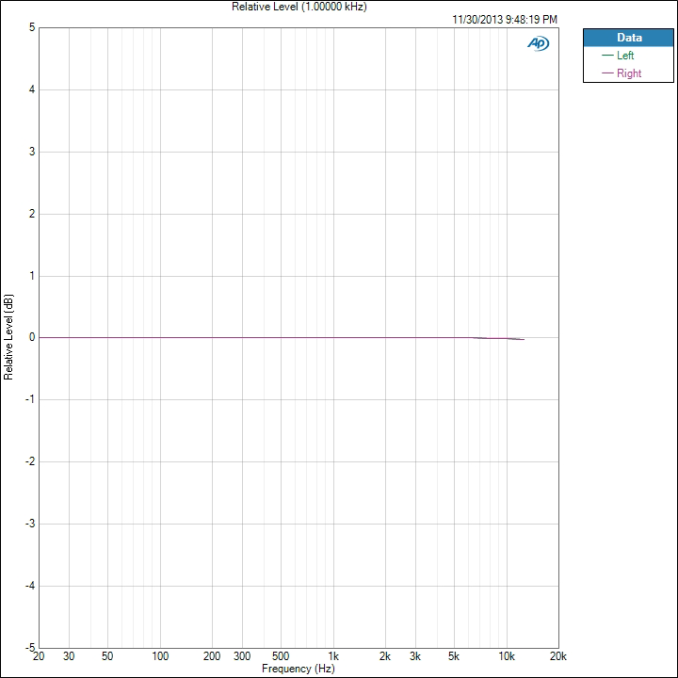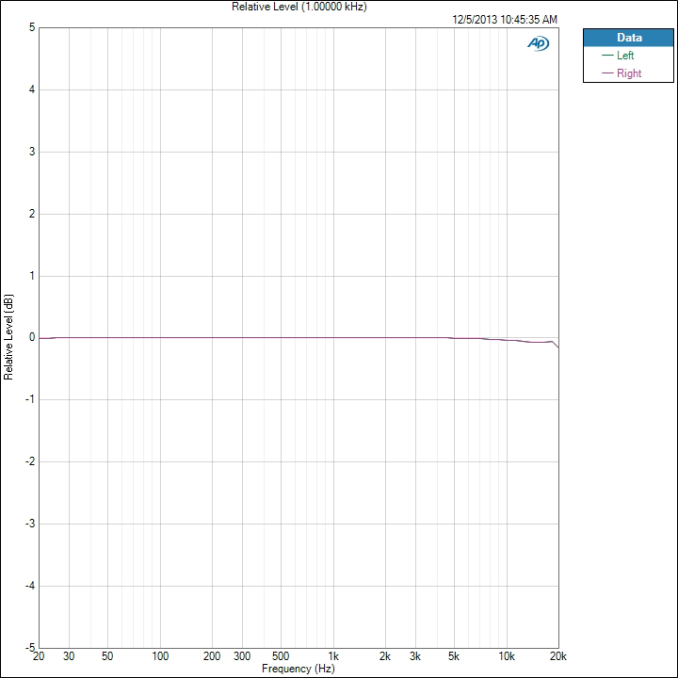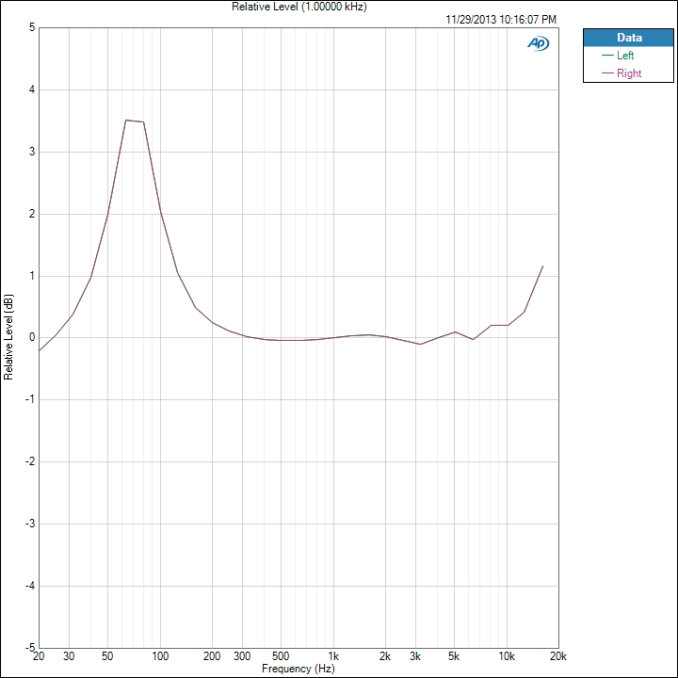Smartphone Audio Quality Testing
by Chris Heinonen on December 8, 2013 5:15 PM EST- Posted in
- Smartphones
- Audio
- Mobile
- Tablets
- Testing
Maximum Level
The maximum output level is derived from the 1kHz test tone used to determine THD+N. The higher the output from the headphone jack, the louder it can drive a pair of headphones. More importantly, having more power available means when you have dynamic music passages that call for power you are less likely to clip the waveform.
There is no chart to show here, just a number that the Audio Precision gives us. In our test data, the most powerful phone was the iPhone 5, at 32.46 mW of power. Next is the Nexus 5 at 22.24 mW, though we can’t drive it that high. Then the Note 3 at 11.81 mW and finally the Galaxy S4 at 3.895 mW. Doubling the power, from 4 mW to 8 mW, produces a 3 dB increase in volume level. 3 dB is the smallest change in volume levels we can easily hear. So even though the iPhone 5 produces 32 mW vs. 4 mW, that is only a 9 dB difference in volume. 10 dB is doubling the volume, so it isn’t even twice as loud. If you have demanding headphones, you will want as much power as you can get.
Frequency Response
To measure the frequency response we measure a set of 61 tones from 20 Hz to 20 kHz. All of these are then equalized to 1 kHz so we can see the maximum deviation from that level. An ideal phone will be perfectly flat here and allow you to adjust this with an EQ setting, or though your taste in headphones. On this test our best performing phone is the Galaxy S4, as seen here.
The total variation from 1 kHz is only 0.014 dB which is very good. The worst performing phone is the iPhone 5, but its variation is only 0.089 dB.
The iPhone 5 also picked up the 20 kHz tone while the Samsung and many others missed it. If we dropped this tone then it might be just as flat. The iPhone 5 test was run slightly differently, as it can't run the Android test program, which might account for this. For a phone with a different response, here is the HTC One with Beats enabled. Other HTC One testing is still in progress as I write this article.
Here we see that Beats is adding a +3.5 dB boost from 60 Hz to 90 Hz, but the deviation from 0 dB goes from 30Hz to 300 Hz. Past 6.5 kHz we also see a rise in the treble. People often mistake boosted treble for extra detail, which is likely the reasoning behind this. As we see it is far different than the other two examples we looked at.













188 Comments
View All Comments
Impulses - Monday, December 9, 2013 - link
All great suggestions IMO.haukionkannel - Tuesday, December 10, 2013 - link
I allso agree. Maximum volume level is not the same as guality, you have to find measures that are relevant in normal listening volumes. They vary yeas and depends a lot of used headphones. So I would allso recommended of using headphones with different impedanses! One pair of high impedance hifi headphones. One pair of low impedance hifi headphones and one pair of high guality (but commonly used) low impedance headphones.Otherwise it would be like testing 780 triple sli setup using 320p resolution mini monitor...
(Well actually not likely because phones have not been very high guality sound sourses, but I think that you got the point.) Good sound qaulity is important factor to me, so I am very eager to hear more (pun inteded ;-) about these test and allso the results!
DaveSimmons - Monday, December 9, 2013 - link
Thanks for doing this. When my 120 GB iPod dies I'll probably replace it with a smartphone or tablet, so this will help me choose which one to use.estarkey7 - Monday, December 9, 2013 - link
As others have stated, and I will reiterate, Only Anandtech! Bravo!I would love to see a similar article comparing HD Voice for the carriers. I know that test may be more difficult to conduct, but ever since Sprint hyped their HD Voice and didn't deliver, I'd like to see some real engineers do the topic justice.
hlovatt - Monday, December 9, 2013 - link
Congratulations AnandTech, yet again you show the rest of the review industry what they should be doing. Keep up the good work and it should be fascinating to see the full set of results. Thanks.willis936 - Monday, December 9, 2013 - link
Is there any comment on the practical issue of noise at low volumes? Noise floor testing is uncommon but phones are noisy and are typically listened to with sensitive buds. Who cares it'd the dynamic range is 100dB if you never turn the volume up past 30%?pr1mal0ne - Monday, December 9, 2013 - link
I disagree with you testing all phones at maximum volume level1) the max volume differs, some companies may reasonably make the choice to let quality suffer while volume improves. at the least volume needs to be reported alongside these quality discussions. Preferably it would be set to a base volume and tested there.
Tuxedo - Monday, December 9, 2013 - link
Amazing article. I have always been impressed with audio quality on iPhones and disappointed with GS2, GS3, Atrix, Lumia 900 and now OG-Pro. Really shows how much attention Apple pays to the products they build.edwh - Monday, December 9, 2013 - link
what about output impedance?fishjunk - Monday, December 9, 2013 - link
I don't really use the audio jack on my Nexus 5. Are there any tests done on the phone mic and speakers.